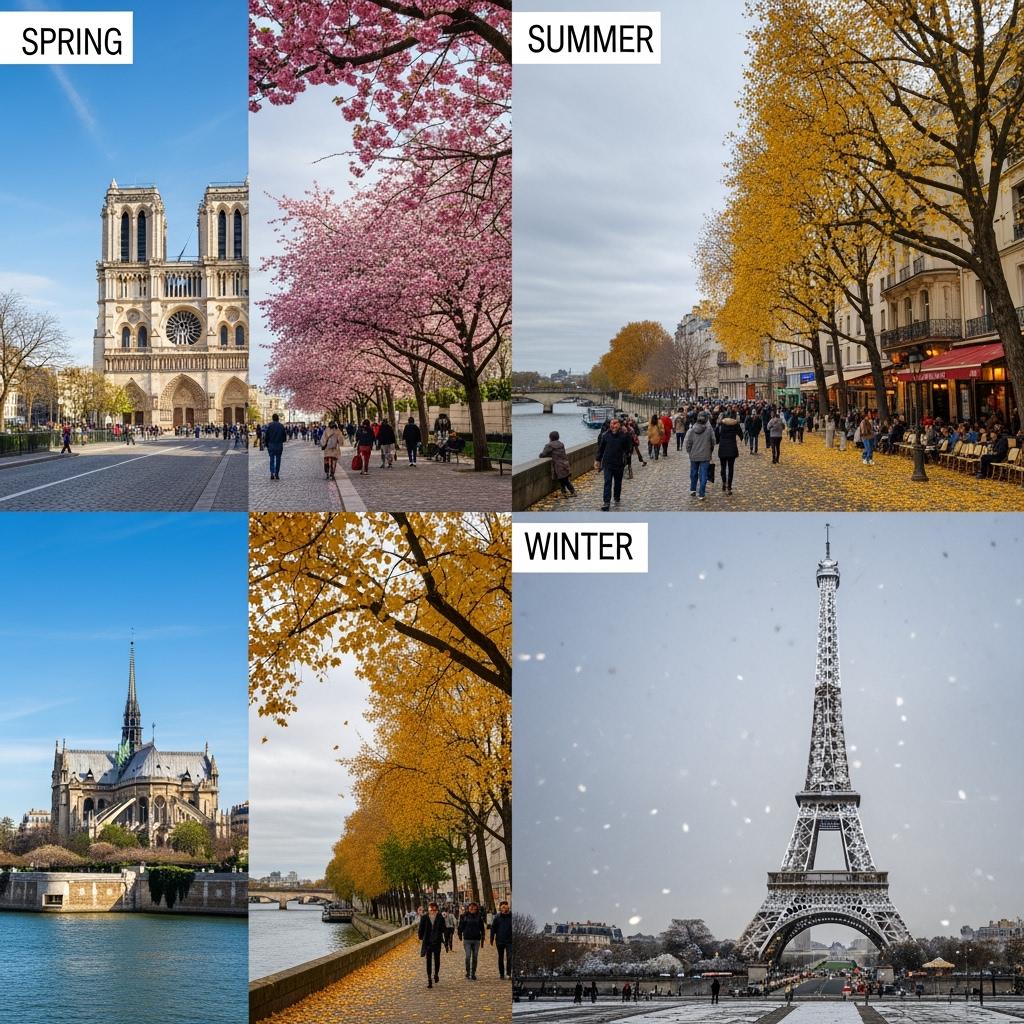
Let’s be honest: Paris has a way of getting under your skin, even before you set foot on its cobblestoned streets. Maybe it’s the stories, the movies, the way people talk about sipping coffee at a little table while Notre-Dame’s bells ring in the distance. For years, I dreamed about going. When I finally made it happen, I realized the magic is real—but so are the logistics! If you’re planning your first (or fifth) trip to Paris and feeling a bit overwhelmed, you’re not alone. I’ve been there. Here’s everything I wish I had known before my visit, along with a few personal stories and hard-earned tips.
When Should You Go? (And Why It Matters)

Paris isn’t just beautiful—it’s moody. The city changes with the seasons, and your experience can depend a lot on when you visit.
Spring (March to May) is my personal favorite. There’s something about Paris in bloom: the cherry blossoms along the Seine, locals sunning themselves outside cafés, and a kind of collective sigh as the city shakes off winter. Bring a light jacket—rain showers are common, but they rarely last.
Summer (June to August) is all about energy. The days are long, parks are full, and the city feels alive. But fair warning: it can get crowded, and August is when many locals go on vacation, so some smaller shops close up.
Fall (September to November) brings a gold glow to the city. The crowds thin out, but the weather stays pleasant. It’s a great time to wander museums or cozy up in a bistro when the air turns crisp.
Winter (December to February) is underrated. Paris is quieter and somehow even more romantic, especially in the run-up to Christmas. You’ll trade longer lines for a chill in the air—and maybe even catch the Eiffel Tower dusted with snow.
Pro tip: If you can, aim for late April to early June or September. You’ll skip the worst crowds but still enjoy great weather.
Booking Flights and Finding Your Parisian Home

I learned this the hard way: Paris is a city where location really matters. Everything looks “close” on a map, but trust me, there’s a world of difference between waking up next to the Seine and being out by the périphérique (the ring road).
Flights:
Start searching about 3–6 months ahead of time if you’re going in peak season. Charles de Gaulle (CDG) is the main international airport, but Orly (ORY) can be more convenient for some European flights. I always set fare alerts and try to be flexible with dates—a day or two can make a big difference in price.
Where to Stay:
- If it’s your first time, stay central. The 1st to 7th arrondissements put you within walking distance of many sights.
- The Marais (3rd/4th) is lively and LGBTQ-friendly, full of bars and vintage shops.
- Saint-Germain-des-Prés (6th) is classic, with bookshops and old-school cafés.
- Montmartre (18th) is artsy, hilly, and feels like its own village.
I once rented a tiny studio in Montmartre that was barely big enough for my suitcase, but peeking out over the rooftops at sunrise made it worth every slightly claustrophobic minute.
Hotels or Apartments?
Paris hotels can be small, but they have charm. If you want to feel like a local, try an Airbnb—but make sure it’s properly registered, as Paris is cracking down on unlicensed rentals.
Getting Around: Metro, Feet, and Flâneuring

The Paris Métro is a marvel—fast, (mostly) clean, and easy to navigate once you get the hang of it. I recommend buying a carnet (pack of 10 single-use tickets) or a Navigo Easy card for multiple days. Download the RATP app for real-time directions.
But honestly? The best way to see Paris is on foot. I can’t tell you how many times I found something magical—a hidden courtyard, a street musician, a crêperie with Nutella wafting out the door—just because I took a wrong turn. Wear good shoes!
Buses are scenic, especially routes 69 and 42. And if you’re feeling adventurous, try the Vélib’ bike system. Just remember: Parisians take their cycling seriously.
Building Your Itinerary (Without Losing Your Mind)

First-time visitors often try to cram every landmark into three days. I get it—I did that, too! But Paris isn’t a checklist; it’s a city to be savored. Here’s how I’d suggest balancing the “must-sees” with some breathing room:
Day 1: The Icons
- Start at the Eiffel Tower (book tickets in advance if you want to go up).
- Stroll the Seine to the Musée d’Orsay for Impressionist art.
- Cross over to Saint-Germain for dinner in a cozy bistro.
Day 2: Heart of the City
- Get lost in the Louvre (tip: pick a few highlights, don’t try to see it all).
- Wander through the Tuileries Garden, maybe grab a pastry at Angelina’s.
- Evening walk in the Marais—grab falafel or people-watch at Place des Vosges.
Day 3: Montmartre and Beyond
- Climb up to Sacré-Cœur early to beat the crowds.
- Explore the artists’ square, little bakeries, and vintage shops.
- Catch a show at Moulin Rouge or just have a late-night wine in Pigalle.
Day 4: Local Life and Surprises
- Visit a market—Rue Cler or Marché des Enfants Rouges are favorites.
- Relax in Luxembourg Gardens, or browse the bookshops on the Left Bank.
- Consider a sunset cruise on the Seine. It’s touristy, yes, but unforgettable.
Bonus Day:
- Take a day trip to Versailles or Monet’s gardens at Giverny if you have time.
Leave space for wandering! Some of my best Paris memories happened when I had “nothing” planned.
Food, Glorious Food: How to Eat Like a Parisian

I’ll say it: Paris really does have the best bread and pastries in the world. Start every morning with a croissant or pain au chocolat from a neighborhood boulangerie—skip the chains and look for lines of locals.
Must-tries:
- Baguette: Grab one for a picnic by the river.
- Cheese: Head to a fromagerie and ask for recommendations.
- Crêpes: Find a street vendor, or try Breizh Café in the Marais.
- Café culture: Order a “café crème” and linger. You’ll never be rushed out.
A tiny confession: I had a “real” French meal only on my last night—most days, I was too busy exploring and survived on bread, cheese, and fruit from local markets. It was perfect.
Practical Tips (a.k.a. Stuff I Wish I Knew)

- Language: Start every interaction with “Bonjour, Madame/Monsieur” and end with “Merci!” Even if your French is terrible, the effort counts.
- Money: Credit cards are widely accepted, but I always kept a little cash for small shops or markets. Tipping is minimal—round up or leave a euro or two.
- Dress: Parisians are stylish, but not flashy. Bring comfortable, neat clothes and one “nicer” outfit if you want to splurge on a fancy dinner.
- Safety: Watch for pickpockets, especially on the Metro and in touristy areas. I used a crossbody bag and kept my hand on it in crowds.
- Sunday Closures: Many shops and even some restaurants are closed Sunday or Monday, so check ahead.
Mistakes to Avoid
- Trying to do too much: You’ll burn out. Pick a few “big” sights and leave time for wandering.
- Dining only near tourist attractions: Walk a few blocks away and you’ll find better food at lower prices.
- Not reserving ahead: For popular restaurants and museums, book online if you can (the Louvre and Eiffel Tower especially).
Making Memories

Bring a notebook, sketch, take photos—but don’t forget to put the camera down sometimes and just…be. One of my favorite Paris moments was sitting on the steps of Sacré-Cœur at dusk, listening to street musicians with locals and tourists all mingling together.
Final Thoughts

Paris is a city of little joys: the smell of fresh bread, the golden light at sunset, a shared laugh with a stranger over a map. There’s no one “right” way to see it. Go with a plan, but leave room for surprises. That’s when the real magic happens.
If you’re planning a trip, I hope these tips help. If you’ve been before, what did you love most? Drop your stories or questions in the comments—I never get tired of talking about Paris.
Bon voyage, and happy travels!
Have questions or need more tips? Leave a comment below—let’s make your Paris trip unforgettable.


